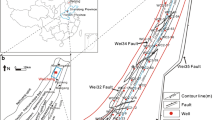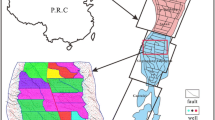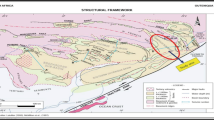Abstract
After years of water injection, the underground movement of oil and water in Daqingzijing oilfield is becoming more and more complex, and the distribution of reservoir parameters between wells and remaining oil is difficult to predict. The reservoir geological model of H56 block in Daqingzijing oilfield is established with the support of numerous data by applying stochastic modeling techniques; it effectively reproduces the reservoir heterogeneity and distributes parameters in uncertain area between wells. A sequential indicator simulation algorithm is used to simulate the sedimentary facies, and facies-controlled reservoir characteristics have been performed including the reservoir petrophysical parameters and variability in the wells. In order to verify model accuracy, a comparison of porosity and permeability between model data and actual data is essentially made, the fitting of reserves and the original reserves were compared, and the whole field and the single well between the model and the history data were compared; the model shows consistency that gives confidence in using the model for numerical simulation purposes.









Similar content being viewed by others
References
De Costa e Silva AJ, Soares A, Almeida J, Ramos L, Carvalho J (1997) A multistep approach for modeling oil reservoir lithologies and petrophysical attributes based on the integration of geostatistics and geology, vol. 96(1). In: Baafi EY, Schofield NA (eds) . Geostatistics Wollongong Kluwer Academic Pub, Dordrecht, pp. 327–338
Deutsch CV, 2000. Integration of geological, geophysical, and historical production data in geostatistical reservoir modeling. Canadian Society of Exploration Geophysicists Annual Meeting Abstracts
Fincham AE, Christensen JR, Barker JW (2004) Up-gridding from geological model to simulation model: review, applications and limitations. Soc Pet Eng 90921:26–29
Franseen EK, Esteban M, Ward WC, Rouchy JM (1996) Models for carbonate stratigraphy from Miocene reef complexes of Mediterranean regions, vol. 5, Concepts in sedimentology and paleontology. Society for Sedimentary Geology, Tulsa, p. 391
Freulon XC, Dunderdale ID (1994) Integrating field measurements with conceptual models to produce a detailed 3D geological model. Soc Pet Eng 28877:25–27
Hu XL, Xue JD (2007) An application of sequential simulation to reservoir modeling. J Chengdu Univ Technol (Sci Technol Ed) 34(6):609–613
Keogh KJ, Maritinus AW, Osland R (2007) The development of fluvial stochastic modeling in Norwegian oil industry: a historical review, subsurface implementation and future directions. Sediment Geol 202(2007):249–268
Kostenevich KA, Dyshlevskiy MB (2010) Construction of detailed 3D geological model of a deposit with difficult geological structure on the basis of basic facies models. Soc Pet Eng 136422:26–28
Li PJ (2000) Three-dimensional simulation and visualization of stratified geological body. Earth Sci Front:271–277
Li JZ, Yang T, Wang LW (2004) The fault structure and its controlling role to hydrocarbon accumulation in Daqingzijing area, Southern Songliao Basin. Pet Explor Dev 31(1):18–20
Lü XG, Li CS, Cai XY, Li BH, Zhao HQ (1999) Depositional characteristics and front facies reservoir framework model in SongLiao shallow lacustrine delta. Acta Sedimentol Sin 17(4):572–577
Qi L, Carr TR, Goldstein RH (2007) Geostatistical three-dimensional modeling of oolite shoals, St. Louis Limestone, southwest Kansas. AAPG Bull 91(1):69–96
Qiu YN, Chen ZQ (1996) Reservoir description. Petroleum Industry Press, Beijing, pp. 330–335
Wang JH, Zhang TF (2001) Oil and gas reservoir stochastic modeling, China. Petroleum Industry Press, Beijing
Wang ZZ, Shi ZZ (1999) Modern reservoir characterization technology. Petroleum Industry Press, Beijing
Zhang JL, Xie J (2008) Reservoir facies models, China. Petroleum Industry Press, Beijing
Zhang YL, Xiong QH, Wang ZZ (1997) Non-marine reservoir description. Petroleum Industry Press, Beijing, pp. 20–35
Zhang YW, Liu LF, Ouyang J (1995) Multiple-discipline research on hydrocarbon reservoirs. Petroleum Industry Press, Beijing
Zhao ZK, Zhang JL, Zhao ZY, Zhang DW (2009) Reservoir sedimentary in Southern Sonliao Basin, China. Petroleum Industry Press, Beijing
Author information
Authors and Affiliations
Corresponding author
Rights and permissions
About this article
Cite this article
Hou, J., Ding, F. & Li, W. A stochastic modeling study of H56 block in Daqingzijing oilfield. Arab J Geosci 8, 10371–10380 (2015). https://doi.org/10.1007/s12517-015-2009-y
Received:
Accepted:
Published:
Issue Date:
DOI: https://doi.org/10.1007/s12517-015-2009-y




